M.U.L.E. The Board Game is A board game based on a 1983 computer game…
…that I haven’t played.
You are one of the pioneering and industrious species of a Galactic Federation. Together with your fellow colonists, you attempt to settle the distant Planet Irata with the so-called help of a mule-like machine you all learn to hate. But for now, he’s all you’ve got. Well, him and your fellow colonists. I wouldn’t count on their help, though — not unless there’s profit. Good luck. You’ll need it.
M.U.L.E. The Board Game is played over 7 rounds, each with 8 phases. As it’s quite an in-depth game I’ll sum up each of those phases… But basically, it’s an economic game with some random elements where obtaining the most value (Money + Land + MULE) is the way to win.
There are some optional elements and variants I added in so I’ll just go over the way we played it here.
1 – Expansion
This starts with the Land Grant by picking up land tiles from the main Planet board and dropping them onto your board. The land tiles have different symbols for Smithore, Energy and Food and this shows how many of each of those resources your MULEs can mine on that tile.
The question mark is Crystite, this is a big money maker but the amount of it you can get is hidden until you mine that tile or look under it by taking an action later on.
In the first round, you do this Phase twice to get you going.
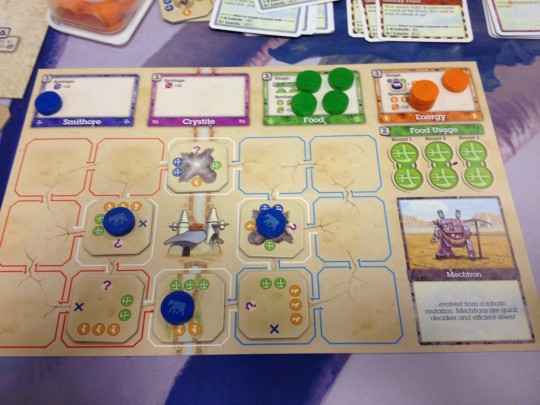
2 – Development
This is the main action phase. You spend food to take action by moving it to your usage box from your supply.
Before this phase is started you turn Smithore in the main supply into MULEs.
Most of the actions you have to pick from involve buying MULEs from the supply, Moving MULEs around your player board and Changing a MULE’s current job. When you place a MULE on a tile you orientate the tile so the resource you want it to mine is facing upwards and you can spend food to change them around if you want.
You can secretly look under any 2 tiles in the game to see which are worth Crystite and which are not.
Then, of course, you can ‘Hunt the Wumpus’. This involves a 4-in-12 random flip off the top of a deck of cards… See a Wumpus icon? Gain $10.
You can drop out of all the action phases altogether by ‘Gambling at the Pub’ and gaining $5.
Each action costs either 1 or 2 food and you can spend up to two food on your turn. This goes around the table 3 times or until everyone has passed.
3 – Usage and Spoilage
You have to fuel your MULEs by paying 1 energy per MULE that isn’t mining Energy. Those mining energies are essentially powering themselves.
Any that you can’t pay won’t mine resources this round.
Then you lose half your remaining food and a quarter of your remaining energy. You can also only store 12 of each resource so any extra is discarded too
4 – Production
You draw a Production card that gives an effect on Production for the round. If you draw ‘The Ship is Back!”, which is always on the bottom of the deck, then the game will end this round.
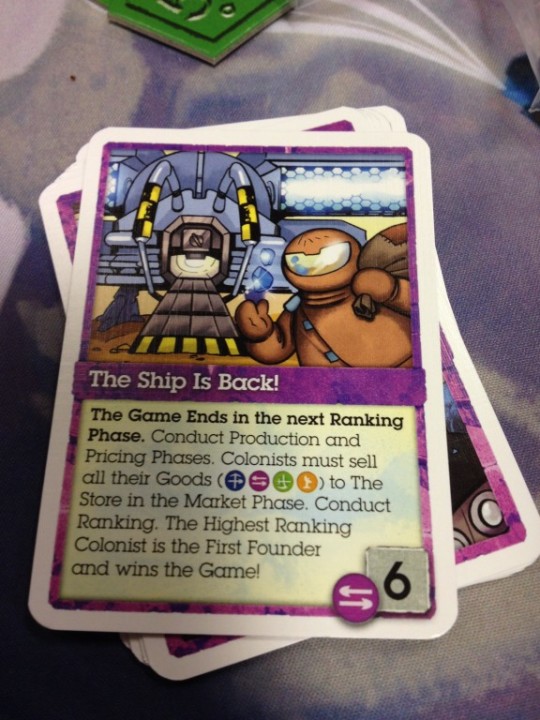
Then you take the resources you mined this turn them into your supply.
You also gain an extra resource if you have 2 or more adjacent tiles mining the same thing.
5 – Pricing
This will change the value of each resource in a slightly different way for each. It mainly has to do with how much is in the main supply, the more there is the cheaper it gets. That 6 on the card in the image above sets the price of Crystite for the round.
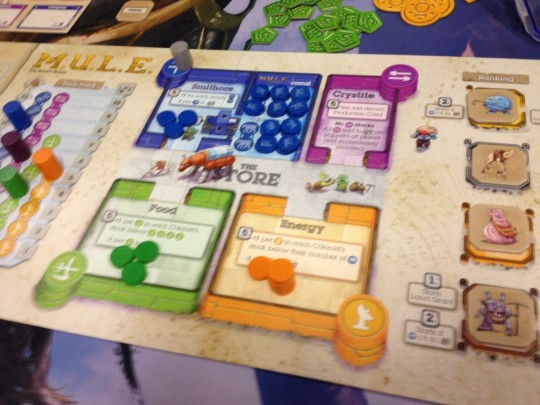
6 – Market
This is where you buy resources for the main supply and each other. The price set in the pricing phases determines how much you can buy or sell to the main supply but players can trade with each other freely. For each resource, you can either buy OR sell, never both in a round.
7 – Ranking
Now you rearrange turn order from richest to poorest. This is based on your wealth but we also played the optional rule where the number of land tiles and MULEs you have been added to this total.
If this is the last round, the first-ranked player will now win the game.
8 – Personal Events
Then you draw event cards. The rules say the current highest ranked player draws a Lucky (positive) Event card and gives it to any player. Then, that player draws an Unlucky (negative) Event card and gives it to another player…
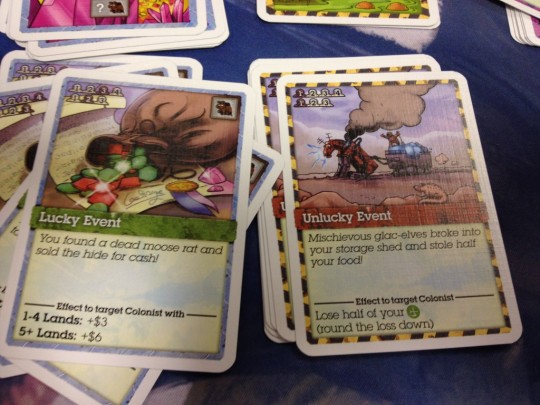
However, each card has a number in the top left that distributes the card itself. In a 4 player game, the Lucky card goes mostly to 4th place, sometimes 3rd. The Unlucky card goes mostly to 1st place, sometimes 2nd.
M.U.L.E. The Board Game Summary
This game is good… The rulebook, not so much, even in its newer versions.
The first turn seems dodgy too as you buy resources based on a random player order so if you’re first you go last so you’re screwed for no reason it seems. I think in future plays we will have this knowledge and play the game smarter.
I don’t think we missed anything, I think we misplayed. The prices start off VERY cheap so we bought a lot and then wasted a fair bit in the first Spoilage phase.
Also, there are Alien cards that give you player power and varied starting set-ups and whoever is in the first place and therefore acts last will get to pick one first… so there’s that. Self-balancing maybe…
The gameplay is pretty fun, it’s very easy and straightforward with plenty to do and not enough resources to do it all.
However, it is random. Those production cards can screw up around but that affects everyone, it just might hurt you more 🙂 The Unlucky/Lucky events can hurt 2nd place and reward 3rd if drawn that way in the way we played.
I like how the market prices fluctuate based on supply, not unique but cool. it’s one of the best parts of Power Grid.
If played in the right way it will be enjoyable, but another play of M.U.L.E. The Board Game is required to test that first round and see if I like the game as much the second time around.
Jesta ThaRogue
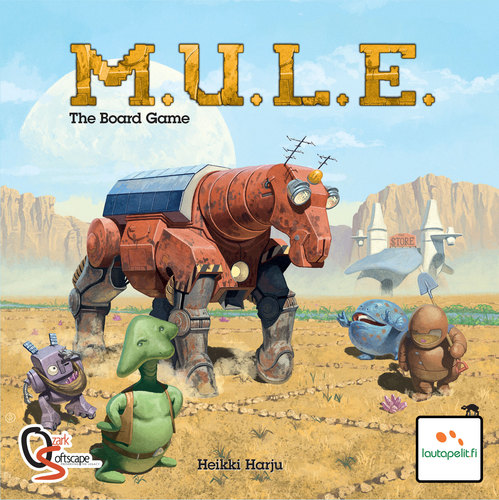


Leave a Reply